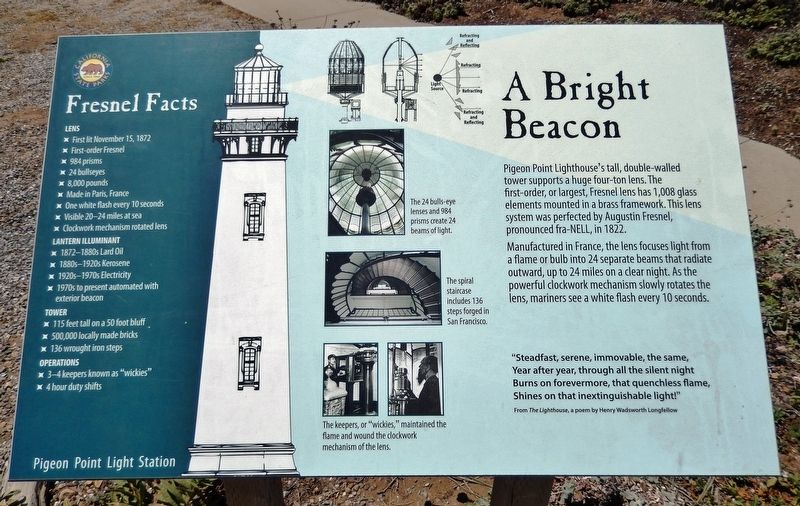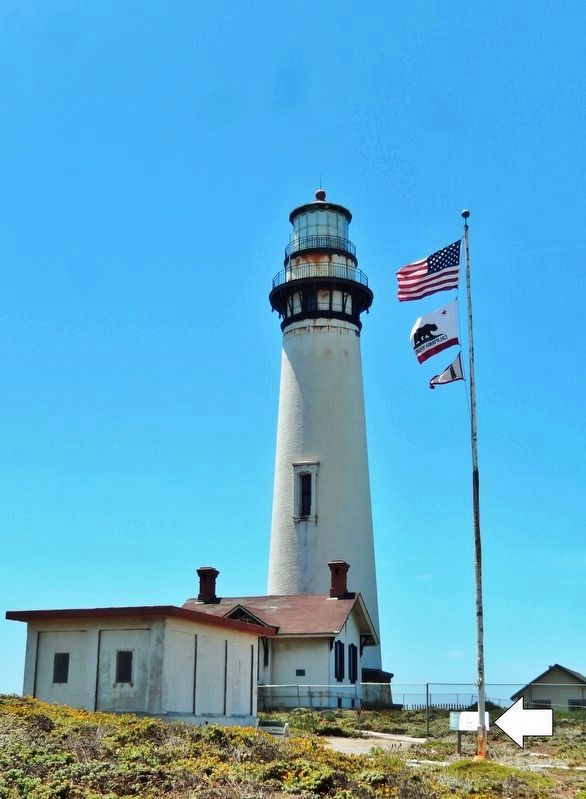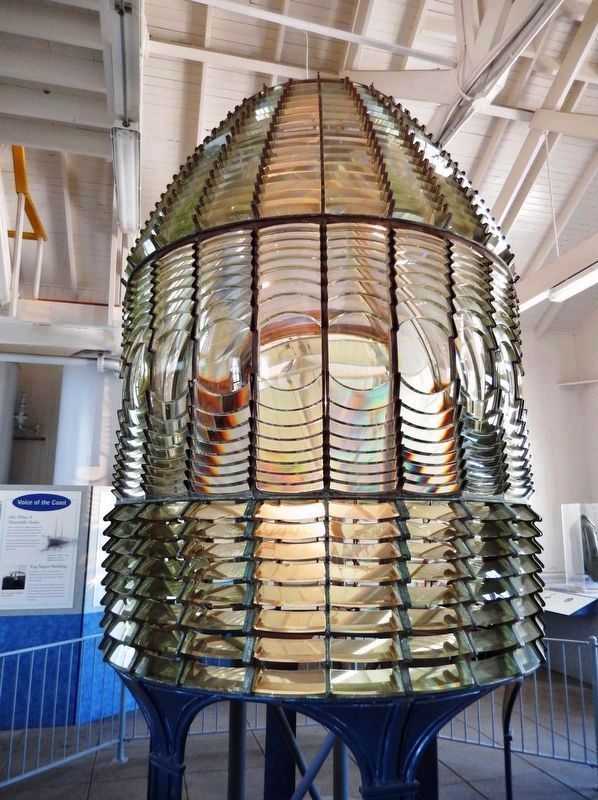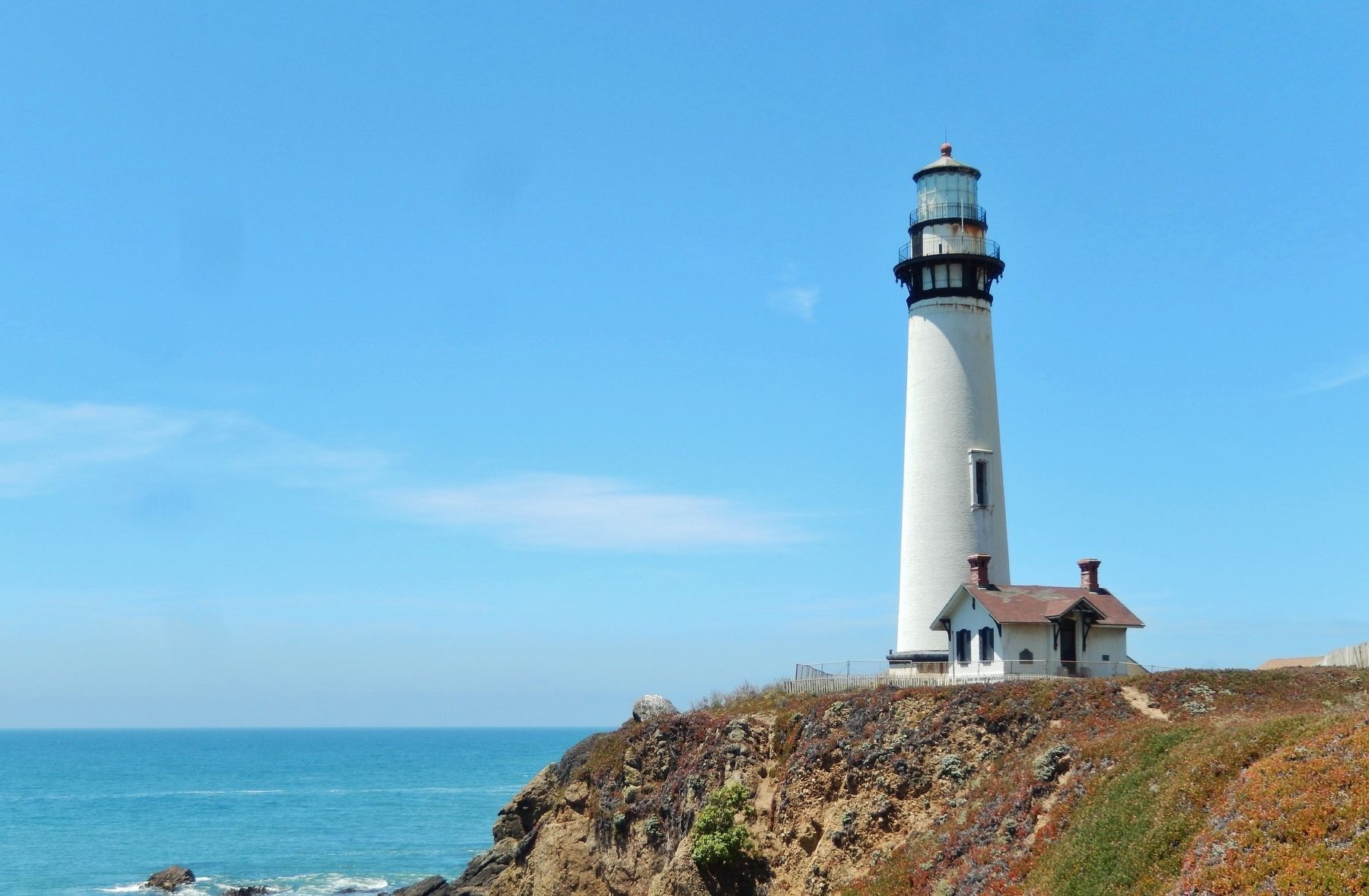Near Pescadero in San Mateo County, California — The American West (Pacific Coastal)
A Bright Beacon
Pigeon Point Light Station
Pigeon Point Lighthouse's tall, double-walled tower supports a huge four-ton lens. The first-order, or largest, Fresnel lens has 1,008 glass elements mounted in a brass framework. This lens system was perfected by Augustin Fresnel, pronounced fra-NELL, in 1822.
Manufactured in France, the lens focuses light from a flame or bulb into 24 separate beams that radiate outward, up to 24 miles on a clear night. As the powerful clockwork mechanism slowly rotates the lens, mariners see a white flash every 10 seconds.
"Steadfast, serene, immovable, the same,
Year after year, through all the silent night
Burns on forevermore, that quenchless flame,
Shines on that inextinguishable light!"
From The Lighthouse, a poem by Henry Wadsworth Longfellow
(photo captions)
The 24 bulls-eye lenses and 984 prisms create 24 beams of light.
The spiral staircase includes 136 steps forged in San Francisco.
The keepers, or "wickies," maintained the flame and wound the clockwork mechanism of the lens.
Fresnel Facts
Lens
First lit November 15, 1872
First-order Fresnel
984 prisms
24 bullseyes
8,000 pounds
Made in Paris, France
One white flash every 10 seconds
Visible 20-24 miles at sea
Clockwork mechanism rotated lens
Lantern Illuminant
1872-1880s Lard Oil
1880s-1920s Kerosene
1920s-1970s Electricity
1970s to present automated with exterior beacon
Tower
115 feet tall on a 50 foot bluff
500,000 locally made bricks
136 wrought iron steps
Operations
3-4 keepers known as "wickies"
4 hour duty shifts
Topics and series. This historical marker is listed in these topic lists: Architecture • Parks & Recreational Areas • Waterways & Vessels. In addition, it is included in the Lighthouses series list. A significant historical date for this entry is November 15, 1872.
Location. 37° 10.923′ N, 122° 23.633′ W. Marker is near Pescadero, California, in San Mateo County. Marker can be reached from Pigeon Point Road, 0.2 miles west of Cabrillo Highway (State Route 1). Marker is located within Pigeon Point Light Station State Historic Park, overlooking the lighthouse from its east side. Touch for map. Marker is at or near this postal address: 210 Pigeon Point Road, Pescadero CA 94060, United States of America. Touch for directions.
Other nearby markers. At least 8 other markers are within 5 miles of this marker, measured as the crow flies. Light Up the Future (here, next to this marker); Savage Seas (within shouting distance of this marker); a different marker also named Light Up the Future (within shouting distance of this marker); Pigeon Point Lighthouse
(about 300 feet away, measured in a direct line); Pigeon Point Light Station State Historic Park (about 300 feet away); Methodist Episcopal Church of Pescadero (approx. 4.7 miles away); a different marker also named Methodist Episcopal Church of Pescadero (approx. 4.8 miles away); Duarte's Tavern (approx. 4.9 miles away). Touch for a list and map of all markers in Pescadero.
Regarding A Bright Beacon. National Register of Historic Places #77000337. Also a California Historical Landmark.
Related markers. Click here for a list of markers that are related to this marker. Pigeon Point Light Station
Also see . . .
1. Pigeon Point Light Station (Wikipedia). The tower stands on a rocky promontory and has long been a landmark for ships approaching San Francisco Bay from the south. This headland, and hence the lighthouse, took its name from the ship Carrier Pigeon that wrecked here in 1853. (Submitted on August 27, 2020, by Cosmos Mariner of Cape Canaveral, Florida.)
2. Pigeon Point Light Station State Historic Park. Perched on a cliff on the central California coast, 50 miles south
of San Francisco, the 115-foot Pigeon Point Lighthouse, one of the tallest lighthouses in America, has been guiding mariners since 1872. (Submitted on August 27, 2020, by Cosmos Mariner of Cape Canaveral, Florida.)
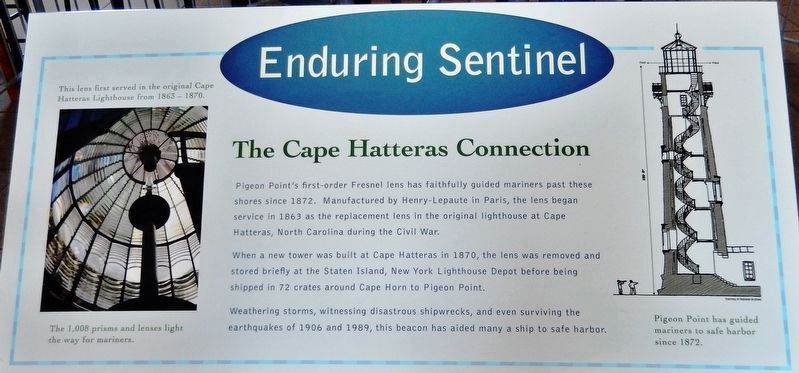
Photographed By Cosmos Mariner, June 19, 2015
4. Enduring Sentinel
(interpretive panel inside Fog Signal Building)
(interpretive panel inside Fog Signal Building)
When a new tower was built at Cape Hatteras in 1870, the lens was removed and stored briefly at the Staten Island, New York Lighthouse Depot before being shipped in 72 crates around Cape Horn to Pigeon Point.
Weathering storms, witnessing disastrous shipwrecks, and even surviving the earthquakes of 1906 and 1989, this beacon has aided many a ship to safe harbor.
(photo captions)
This lens first served in the original Cape Hatteras Lighthouse from 1863-1870.
The 1,008 prisms and lenses light the way for mariners.
Pigeon Point has guided mariners to safe harbor since 1872.
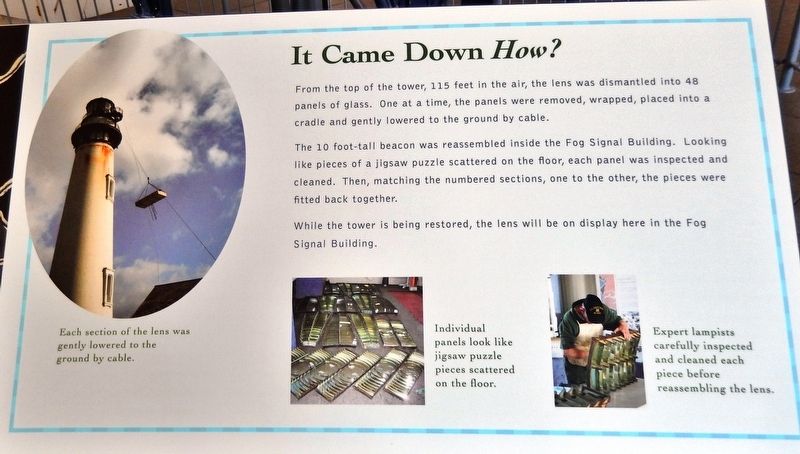
Photographed By Cosmos Mariner, June 19, 2015
5. It Came Down How?
(interpretive panel inside Fog Signal Building)
(interpretive panel inside Fog Signal Building)
From the top of the tower, 115 feet in the air, the lens was dismantled into 48 panels of glass. One at a time, the panels were removed, wrapped, placed into a cradle and gently lowered to the ground by cable.
The 10 foot-tall beacon was reassembled inside the Fog Signal Building. Looking like pieces of a jigsaw puzzle scattered on the floor, each panel was inspected and cleaned. Then, matching the numbered sections, one to the other, the pieces were fitted back together.
While the tower is being restored, the lens will be on display here in the Fog Signal Building.
(photo captions)
• Each section of the lens was gently lowered to the ground by cable.
• Individual panels look like jigsaw puzzle pieces scattered on the floor.
• Expert lampists carefully inspected and cleaned each piece before reassembling the lens.
The 10 foot-tall beacon was reassembled inside the Fog Signal Building. Looking like pieces of a jigsaw puzzle scattered on the floor, each panel was inspected and cleaned. Then, matching the numbered sections, one to the other, the pieces were fitted back together.
While the tower is being restored, the lens will be on display here in the Fog Signal Building.
(photo captions)
• Each section of the lens was gently lowered to the ground by cable.
• Individual panels look like jigsaw puzzle pieces scattered on the floor.
• Expert lampists carefully inspected and cleaned each piece before reassembling the lens.
Credits. This page was last revised on February 23, 2023. It was originally submitted on August 26, 2020, by Cosmos Mariner of Cape Canaveral, Florida. This page has been viewed 209 times since then and 20 times this year. Photos: 1, 2, 3, 4, 5, 6. submitted on August 27, 2020, by Cosmos Mariner of Cape Canaveral, Florida.
